Chapter Books
1. Twilight by Stephanie Meyer
2. The Hunger Games by Suzanne Colllins
3. Joey Pigza Loses Control by Jack Gantos (Newbery Award)
4. The Cricket in Times Square by George Seldem (Newbery Award)
5. Hatchet by Gary Paulsen (Newbery Award)
6. Holes by Louis Sachar (Newbery Award)
7. Wild Times at the Bed and Biscuit by Joan Carris (Blue Bonnet Award)
8. The Witche's Guide to Cooking With Children by Keith Mcgowan (Blue Bonnet Award)
9. The Buddy Files: The Case of the Lost Boy by Dori Hillestad Butler (Blue Bonnet Award)
10. Keeping the Night Watch by Hope Anita Smith (Coretta Scott King)
11. Lockdown by Walter Dean Myers (Coretta Scott King)
12. Joey Pigza Swallowed the Key by Jack Gantos (Challenged Book)
13. Esio Trot by Roald Dahl (Challenged Book)
14. How To Eat Fried Worms by Thomas Rockwell (Challenged Book)
15. On My Honor by Marion Dane Bauer (Challenged Book)
Picture Books
1. The Beebee Bird by Diane Redfield Massie (Challenged Book)
2. The Hallelujah Flight by Phil Bildner (Blue Bonnet Award)
3. The Lion and the Mouse by Jerry Pinkney (Caldecott Medal Award)
4. The House in the Night by Susan Marie Swanson (Caldecott Medal Award)
5. Flotsam by David Wiesner (Caldecott Medal Award)
6. The Man Who Walked Between the Towers by Mordicai Gerstein (Caldecott Medal Award)
7. Los Gatos Black onHalloween by Marisa Montes (Pura Belpre)
8. My Colors, My World / Mis Colores, Mi Mundo by Maya Christina Gonzalez (Pura Belpre)
9. Papa and Me by Arthur Dorros (Notable Children's Book)
10. A Couple of Boys Have the Best Week Ever by Marla Frazee (Notable Children's Book)
11. Chicken Said, "Cluck!" by Judyann Ackerman Grant (Notable Children's Book)
12. Freckleface Strawberry by Julianne Moore (New York Times Bestseller)
13. Grace for President by Kelly Dipucchio (New York Times Bestseller)
14. Hide and Sheep by Andrea Beaty (New York Times Bestseller)
Thursday, July 14, 2011
Wednesday, July 13, 2011
Personal Reaction Blog
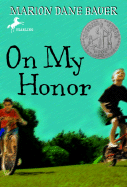
On My Honor by Marion Dane Bauer
I went through a rollercoaster of emotions with this book. I felt betrayal when Joel lies to his dad and daring when the boys swam in the Vermillion River and wanted to climb the bluffs. I was frightened when Tony went missing and desperate when Joel didn't know what to do about his missing friend. Confused about how to face his parents, the police, and worst of all - Tony's parents! I felt guilty and furious when the father finds out he let them go bike riding across town where it all started. He was the adult and should have known better. The author did an astonishing job making me feel what the characters were feeling and that is quite an accomplishment. Not all books have that quality. Officially one of my favorites!
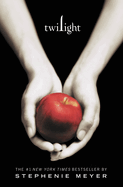
Twilight by Stephenie Meyer
The author does a great job with Isabella's character portraying her as not your normal teenager. It's conflict is a classic but the way the author express the romance in the book is amazing. The story reminds me of highschool love. Where the other person is the most important everything. Where you are willing to do anything for them and there are no impossibles. It made me wonder when they were going to do "it" over and over again. So it had me in suspense. Excellent book choice. :)
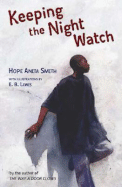
Keeping the Night Watch by Hope Anita Smith
This book has a strong message: What doesn't kill you, makes you stronger! This book reminds me of a middle school friend who would always complain about her dad and asked the same question, why did he leave? The author does a fantastic job telling the reader in great detail how the character's anger toward his dad grows. Like the character, my friend took over her dad's responsibilities or atleast that's what she felt. I haven't spoken to her in a long time, but she hadn't made up with her father the last time I spoke with her. Great book to share with children experiencing separation or divorced parents.

Los Gatos Black on Halloween by Marisa Montes
The book has a particular style of word choice. The first phrase "Los gatos black with eyes of green" reminded me of my fourth grader's compositions. They always write spanish words that they can't translate and put the adjective after the noun. This is a great book to read in autumn, Halloween, or "El Dia de los Muertos" since my class is usually 95% hispanic.
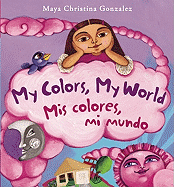
My Colors, My World: Mis Colores, Mi Mundo by Maya Gonzalez
The book is nicely written in English and Spanish. I like the way the author explains the desert and its sunset. This book is for young children that are learning their colors in two languages. I showed it to my daughter and she specially liked the page of inviting her guests for tea because she loves the color purple.

Joey Pigza Swallowed the Key by Jack Gantos
This book makes me understand children with ADHD better. As a teacher, I've had students who suffer from this condition and it's not easy for them. They need to be aware of their hyperactivity all the time to make sure they are not bothering others or their own learning. Unfortunately because they are so active, they lose on some instructional time. They tend to need special attention and help from afterschool programs such as tutoring centers. I love Joey Pigza's character for being so realistic.
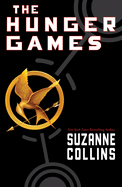
The Hunger Games by Suzanne Collins
This book reminded me of one thing, Reality TV. It's a version of Survival where candidates are stranded on an island and are challeged to defeat the others. Except the participants don't kill each other and the winners get cash not food. The story also reminded me of my fathers stories when we were growing up. He would tell us how hard it was to be responsible for his 12 smaller sibblings when my grandfather died. Katniss takes the roles of her father and mother for a few years and feels completely responsible to protect her sister from such harsh games. My favorite part of the book was when Katniss is looking for Rue and finds her caught in a net. As Katniss approaches her, Rue is shot in the chest. Nooooo! It happened so fast I didn't expect it. Awesome Book! :)
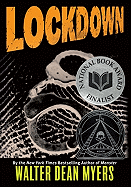
Lockdown by Walter Dean Myers
The author does a tremendous job in communicating the voice of urban black teenagers. Reese's narration is so well-written that it captivates the reader and convinces that the character is desperate. Love the real life story plot and how the conflicts slowly rise. Even in his times of hopelessness, Reese's desire to help his sister make her goals a reality is inspiring. I had never read such a compelling book like this and have already recommended it to my 14 year old nephew. I know he will enjoy it!
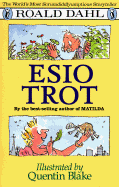
Esio Trot by Roald Dahl
Cuttest chapter book ever! The story shows how being a determined person can get anyone what they want - with a few tricks, ofcourse. I loved how the author was able to put love, romance, suspense, and a happily ever after all in one short story. I enjoyed how the author gave us an explanation as to what happens with Tortoise #1 at the end. Great book to read at the beginning of the year to show that you can work through any problem as long as you keep trying (motivation).
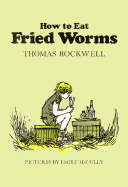
How To Eat Fried Worms by Thomas Rockwell
This story took me back when I was growing up in Veracruz, Mexico. We weren't afraid to try anything and we bet each other all the time to do crazy stunts. Nothing was impossible for us and we wanted to try new things - explore. Never a boring day! Even though it isn't mentioned, I think the author wrote a bit about his upbringing because it has to take someone with personal experience to think like a kid and write about it so well. Great book to share with kids who don't spend a lot of time outdoors and might be motivated to play outside with the ideas given in this book.

The Baby Beebee Bird by Diane Redfield Massie
This picture book is about how a new baby bird arrived at the zoo and won't let any animal sleep. The zoo animals join forces and plan to make sure they don't spend another sleepless night. The animal's dialogue is halarious, entertaining, and the author emphasizes several words by capatalizing. This book is perfect for young reader who like animals and might be thinking to head out on a zoo field trip.

Freckleface Strawberry by Julianne Moore
This warm, loving, heart-felt story shows kids to love themselves no matter what. The author tells the reader that whatever they don't like about themselves, freckles or hair color, they need to learn to live with it because that is what makes them unique. Everyone is different and children need to learn how to accept that. This book teaches young children to accept themselves for who they are and not try to change or hide what make them special but should embrace it.

Hide and Sheep by Andrea Beaty
After the farm's cat casts a spell to "shut up" all the animals, he makes things turn upside down. The dog lets out a Baaa, the chickens oink, and the sheeps bark. The author creates an adorable and comical story about farm animals young readers can enjoy. Her bright, bold, and colorful illustrations make the animals come to life.

Grace For President by Kelly Dipucchio
After Grace learns that no woman has ever been president she decides to run for the presidential election in her class. As Grace becomes a candidate, she soon learns how challenging it is to run a winning campaign. This book introduces political life and electorial politics to youngsters in an interesting and fun reading selection. I plan to use this well-written book when elections in my school start and maybe inspire students to run for treasure, vice-president, or some other political office position.
Monday, July 11, 2011
Papa and Me
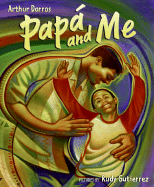
This book does not follow the traditional story plot line. It tells how a boy spends a typical day with his dad. The story shows how well they get along through breakfast, they head out to the park, then to the beach, and finally take a bus home to visit the boy's grandparents. It can be used in the classroom to teach the theme of family and how special we all are. The illustrations in this book help the text and its lines of color swirl in many directions to define different settings. The variation in color impacts the brightness and creates a smooth texture for each illustration.
Dorros, A. (2008). Papa and me. New York, NY: Harper-Collins Publishers.
A Couple Of Boys Have The Best Week Ever
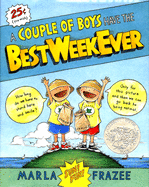
Exposition: On a hot summer day, a boy named James heads out to Nature Camp with his friend Eamon.
Conflict: The grandparents wanted to take them to the Nature Camp but the boy prefered to do something else.
Rising Action: The children spent the whole week inside the house playing with video games, watching T.V., and eating snacks.
Climax: After eating popcorn in the living room area, they decide to held outside for the night.
Falling Action: The children enjoy looking at the stars, playing with shell, and other nature-made things they found.
Resolution: The boys' last night was the best night they had at Nature Camp and hoped to come back soon again.
Excellent illustrations establish the mood and provide a differing viewpoint from the characters than what the text suggests.
Frazee, M. (2008). A couple of boys have the best week ever. Orlando, FL: Harcout, Inc.
Chicken Said, "Cluck!"
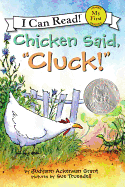
Exposition: Two children, Earl and Pearl, are eager to grow a pumpkin patch.
Conflict: Critters raid the pumpkins for lunch.
Rising Action: They "Shoo" away chicken as the children plant and grow their pumpkin patch.
Climax: Grasshoppers eat and munch on the pumpkins.
Falling Action: The children can't get rid of the grasshopper invasion.
Resolution: Chicken comes to the rescue and "clucks" at the frantic grasshoppers.
The illustrations in this book are well-developed for young readers since they develop and extend the plot while reinforcing the text.
Grant, JA. (2008). Chicken said, "cluck!". New York, NY: Harper-Collins Publishers.
Joey Pigza Loses Control
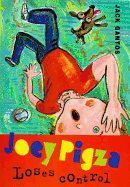
Exposition: Joey Pigza is a youngster that is over active because of his ADHD condition.
Conflict: He is about to meet his father, Carter, after several years and is worried his dad won't like him.
Rising Action: Carter want to make up for all the wrong doing and wants to teach his son how to be a winner in life.
Climax: Trying to teach his son to be like other boys, Carter gets rid of Joey's medicine.
Falling Action: Without his medication, Joey's behavior goes south quickly.
Resolution: Joey desperately tries to please his father even though he knows that his father's decisions are not very wise and are dangerous.
Literary Qualities
1. Character - Many people can relate and identify with Joey Pigza's character including, children, teenages, and even parents.
2. Accuracy - The books makes you understand and see ADHD in a different perspective readers can easily trust.
Gantos, J. (2000). Joey pigza loses control. New York, NY: Farrar, Straus and Giroux
The Cricket in Times Square
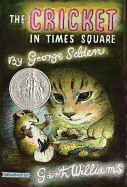
Exposition: Chester Cricket arrives to Times Square in New York City on a train from Conneticut.
Conflicts: Chester is taken from his quiet country place to a noisy city he is not accustomed to and is now a pet for a boy named Mario Bellini.
Rising Action: He meets Tucker Mouse and Harry Cat who live in a drainpipe near the newstand where Cricket lives and become great friends over the summer.
Climax: After sometime, they discover that Chester Cricket can mimic the music he hears from the radio perfectly.
Falling Action: After a letter is written to the New York Times about the cricket's talent, Chester gives concerts and makes the Bellini's a fortune in the newstand. With time, Chester Cricket becomes tired of the concerts and Mario sees how sad he is.
Resolution: Mario encourages Chester to do what makes him happy. Chester decides to go back to his quiet countryside hoping to get a visit from Tucker and Harry someday.
Literary Qualities
1. Pacing - The book's pacing is a literary quality because of the author's ability to linger over the content in detail.
2. Theme - The book teaches children the important of friendship and letting others be happy.
Selden, G. (2008). The cricket in times square. New York, NY: Square Fish.
Hatchet

Exposition: After spending the school year with his mom in New York City, Brian plans to visit his dad for summer vacation in Canada.
Conflict: Brian gets stranded in the Canadian woods after his pilot suffers a heart attack and he is forced to land the plane into a lake.
Rising Action: After becoming injured from the crash, he needs to find food, encounters several wild animals, and tries to find shelter to survive.
Climax: A tornado sweeps over the forest, moves the plane's tail up to the surface of the water, and reminds Brian of the safety kit the plane carried aboard.
Falling Action: Brian uses his hatchet to break into the airplane to find food, the safety kit, and to his luck, an emergency transmitter.
Resolution: After he calls out for help, he is rescued by another plane and is safely taken home.
Literary Qualities
1. Character - The author does a tremendous job in turning this character seem like a real boy because he lets us know what he is feeling and going through in great detail.
2. Plot - The problem of the story is so well-designed that it makes us interested in the book, the character, and its finally.
Paulsen, G. (1999). Hatchet. New York, NY: Scholastic, Inc.
Friday, July 8, 2011
Wild Times at the Bed & Biscuit
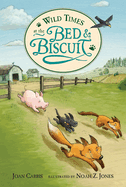
Exposition: A pig, a goose, a dog, a bird, two foxes, and other wild animals end up at the Bed and Biscuit shelter.
Conflict: Ernest the mini-pig has to teach the newest member of the family, a scottish terrier, proper manners.
Rising Action: The doctor helps out several animals that are physically hurt. Climax: Several animals want to play and behave the way they always do out in the wild. The animals start to cause chaos at the shelter and Ernest is trying to keep the shelter under contol.
Falling Action: The animals are returned to the wild where they belong.
Resolution: The terrier understands that while being out in the wild sounds like fun, being in the shelter is much easier to live in and less dangerous.
Literary Qualities
1. Illustrations - The book's art in several occasions were well developed and strengthened the story and characters.
2. Setting - The author explained in detail the physical characteristics of the shelter where the story took place.
Carris, J. (2009). Wild times at the bed & biscuit. York, PA: Candlewick Press.
Thursday, July 7, 2011
The Witches Guide to Cooking with Children
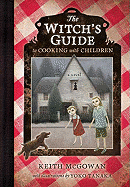
Exposition: Sol, a clever kid who is interested in Science, and his pesty sister Connie have just moved to a town with very few children.
Conflict: In order to get an inheritance, their parents want to get rid of the children with the help of a witch.
Rising Action: Sol suspects their is something different about his friendly neighbor and decides to investigate about her.
Climax: After the children break in to the witch's house, they are distracted for a moment and the witch finds them escaping through her upstairs window.
Falling Action: Connie was captured by the witch and was about to be eaten but Sol helps her escape with one of his scientific inventions.
Resolution: The children push the witch into a firepit and escape thinking they finished her.
Literary Qualities
1. Style and Language - The author had control of all the facts of language to reinforce the witch's part of the story.
2. Plot- The conflict was engaging and dramatic making the reader care about the events in the story and the characters.
Mcgowan, K. (2009). The witch's guide to cooking with children. New York, NY: Henry Holt and Company, LLC.
Wednesday, July 6, 2011
The Buddy Files: The Case of the Lost Boy
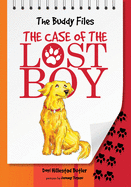
Exposition: King (AKA Buddy) tells his new friends how he ended up in the P-o-u-n-d and wants to find his missing family, Kayla, Dad, and Mom who works with National Guard.
Conflict: Buddy is adopted by Conner and is taken to his new home in his previous neighboorhood.
Rising Action: As Conner walks Buddy around the block, the dog searches for clues to find his family.
Climax: When Buddy returns from his search empty handed, he notices Connor has gone missing, too!
Falling Action: Buddy plans to find Connor and gives Mom enough "Human Talk" to let her know where her son has gone.
Resolution: The clues given by the dog led Mom to Connor and that's why Kayla, previous owner, called him the King of Crime-solving. Now Buddy/King doesn't know if he will go or stay once he finds his family.
Literary Qualities
1. Theme - The story teaches about adjusting to a new town and a new life.
2. Tone - The main character's attitude towards finding his family or accepting a new one is transmitted to the reader.
Butler, DH. (2010). The buddy files: the case of the lost boy. Park Ridge, IL: Albert Whitman & Company.
Holes

Exposition: Teenage Stanley Yelnats has no friends, siblings, but does have a family curse.
Conflict: After being blamed for a crime Stanley didn't commit, he is sent to a correctional camp.
Rising Action: All inmates have to dig holes in the Texas desert from sun rise to dawn.
Climax: Stanley and Zero discover the lost treasure the Warden wants in her possession.
Falling Action: Stanley is saved by the Attorney General when being confronted about the treasure by the Warden.
Resolution: Stanley Yelnats name is on the treasure case and leaves the Warden with nothing but anger.
Literary Qualities
1. Setting - The setting in this story is very important since most of the conflicts occur there.
2. Plot - The author has several conflicts with different characters going at the same time and does it clearly so that the readers care about each character from the story.
Sachar, L. (1998). Holes. New York, NY: Bloomsbury
Flotsam
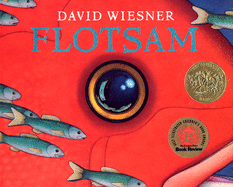
This Caldecott winner illustrates beautifully a story about a curious boy at a beach. He is closely observing several sea critters on shore when a harsh wave brings in an old fashion camera. After developing the pictures, he notices they are so unique and decides to be part of this interesting picture taking method. The illustrations are incredible and full of color, detail, and so realistic. This book didn't need words to express what the other wanted to say. The illustrations established the setting and developed the plot.
Wiesner, D. (2066). Flotsam. New York, NY: Houghton Mifflin Company.
The Hallelujah Flight
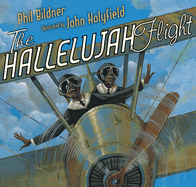
Exposition: James Banning expresses his dream of flying a plane to Mr. Allen over coffee.
Conflict: They didn't have money to repair the plane that would take them on such a journey.
Rising Action: After flying for a while and getting a leaky pump, people pitched in to help them repair the plane since they can sign their name on it.
Climax: People from all over helped with food, water, clothes, tools, and parts for the plane.
Falling Action: After many mechanical problems, they arrived at Long Island, NY.
Resolution: "The Hallelujah Flight" was a success because of the help of so many good hearted people.
The illustrations in the book were well developed since they helped reinforce the plot and establish the different settings.
Bildner, P. (2010). The hallelujah flight. New York, NY: The Pinguin Group.
The Lion and the Mouse
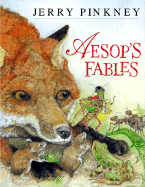
Exposition: In a grassy area, the story introduces a mouse that encounters a lion.
Conflict: The mouse awakens the lion and will be the lion's next meal.
Rising Action: The clever mouse convices the lion to let him go and will be helped by him one day.
Climax: Soon after, the lion needs help and the mouse runs to his side.
Falling Action: The mouse gnawed on the tight and sturdy rope until the lion was free.
Resolution: The ending is a very well known saying, "Even the strongest can sometines use the help of the smallest."
The fable's illustration are not well developed. The book lacks detailed illustrations about the characters and the mood, but it is very well written to teach the story's theme.
Pinkney, J. (2000). Aesop's fables. New York, NY: Sea Star Books.
The Man Who Walked Between the Towers

Exposition: The beginning of the story tells about two towers in New York City.
Conflict: The police would not allow a street performer to walk a line between the two towers.
Rising Action: Philippe thought out a secret plan and carried it out with the help of his friends.
Falling Action: Philippe tied a heavy cable from the top of a tower to the other.
Resolution: Even after police arrived at the site to arrest him, the determined performer walked on the cable for over an hour.
This book was very well illustrated because it's pages open and extend so the reader can get a better visual of how high the character performed his stunt. This helps the setting come to life for the reader.
Gerstein, M. (2003). The man who walked between the towers. New York, NY: Scholastic, Inc.
The House in the Night
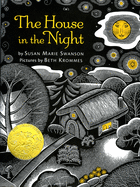 This story does not fit the traditional story plot line. It's rhyming words take the reader from the entrance of the house to a bed with a book. Then a bird sings about the darkness of the night, the moon, and the sun. It tells the story backwards like other poems do such as "Hush, Little Baby." With its cumulative rhymes an amazing illustrations, this book is a great rhyming book for young children to enjoy. The pictures help the author establish the setting and reinforce the text in detail.
This story does not fit the traditional story plot line. It's rhyming words take the reader from the entrance of the house to a bed with a book. Then a bird sings about the darkness of the night, the moon, and the sun. It tells the story backwards like other poems do such as "Hush, Little Baby." With its cumulative rhymes an amazing illustrations, this book is a great rhyming book for young children to enjoy. The pictures help the author establish the setting and reinforce the text in detail.Swanson, SM. (2008). The house in the night. New York, NY: Houghton Mifflin Company
Subscribe to:
Comments (Atom)